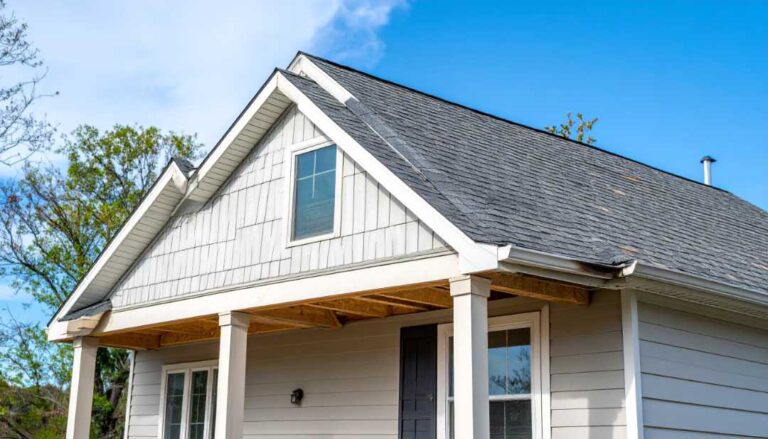The Key to Your Roof Replacement Payout – ACV vs. RCV
The moment a severe storm rolls through Chicagoland, bringing hail, high winds, or heavy snow, your primary concern is the safety of your family and the integrity of your home. Once the immediate threat passes and you discover damage to your roof, the daunting question arises: “How much will my insurance actually pay to replace it?”
This seemingly simple question unlocks one of the most critical, yet often misunderstood, aspects of your homeowner’s insurance policy: the distinction between Actual Cash Value (ACV) and Replacement Cost Value (RCV). These two terms dictate how your insurance company calculates your payout, directly impacting your out-of-pocket expenses for a new roof. For homeowners in Illinois, especially given our region’s propensity for extreme weather, understanding this difference can mean the difference of thousands, or even tens of thousands, of dollars.
At Seidel Exterior Group, we’ve been expertly guiding Chicagoland homeowners through storm damage claims and roof replacements since 1970. We’ve seen firsthand the financial implications of having one type of coverage over the other. This article will thoroughly explain ACV and RCV, detail how they affect your roof replacement check, highlight potential implications specific to Illinois, and ultimately help you understand the true value of your homeowner’s policy.
What is Actual Cash Value (ACV)? The Depreciated Reality
Actual Cash Value (ACV) coverage pays you the depreciated value of your damaged roof at the time of loss. Think of it like this: if your 15-year-old car gets totaled, the insurance company doesn’t pay you the price of a brand-new car; they pay you what your 15-year-old car was worth just before the accident.
- How ACV is Calculated: The insurance company determines the cost to replace your roof with a new one today, and then subtracts depreciation for age, wear and tear, and obsolescence.
- Formula: Replacement Cost – Depreciation = Actual Cash Value
- Example: Imagine your roof was installed 10 years ago for $20,000. If its expected lifespan is 20 years, it might have depreciated by 50% ($10,000). If it’s destroyed by a storm, an ACV policy would pay you $10,000 (minus your deductible). This is often far less than the cost to replace it.
- Impact on Your Wallet: With an ACV policy, you will likely have significant out-of-pocket expenses, as the insurance payout will not cover the full cost of replacing your old roof with a new one.
Key Considerations for ACV in Illinois:
- Lower Premiums: ACV policies generally have lower premiums because the insurer’s potential payout is less.
- Older Roofs: In Illinois, as a roof ages (often 15-20+ years), some insurers may automatically switch coverage to ACV, or only offer ACV, even if you previously had RCV. This is because older roofs are considered higher risk due to their increased likelihood of damage.
- Higher Out-of-Pocket Costs: After a covered loss, your out-of-pocket costs will be higher because the depreciation is not reimbursed.
What is Replacement Cost Value (RCV)? The Full Restoration
Replacement Cost Value (RCV) coverage pays you the amount it costs to repair or replace your damaged roof with new materials of similar kind and quality, without deduction for depreciation. The goal of an RCV policy is to restore your home to its pre-loss functional and aesthetic condition, using new materials.
- How RCV is Paid Out (Often in Two Payments):
- Initial Payment (ACV): The insurance company will typically issue an initial payment based on the Actual Cash Value (ACV) of the damaged roof (Replacement Cost – Depreciation). This provides funds to begin the repairs.
- Recoverable Depreciation Payment: Once the repairs are completed and you submit proof of the actual costs (receipts and invoices from your contractor), the insurance company will release the withheld amount – the recoverable depreciation. This second payment covers the difference between the ACV and the full Replacement Cost, minus your deductible.
- Formula: Replacement Cost – (ACV Payment + Deductible) = Recoverable Depreciation (second check)
- Example: Using the previous scenario: Your 10-year-old roof costs $20,000 to replace. With an RCV policy and a $1,000 deductible:
- Initial Check (ACV): ~$9,000 (original ACV of $10,000 minus $1,000 deductible)
- You Pay Contractor: You pay the contractor the $9,000 from the first check plus your $1,000 deductible, totaling $10,000.
- Contractor Completes Work: The new roof costs $20,000.
- You Submit Invoice: You provide the $20,000 invoice to your insurer.
- Second Check (Recoverable Depreciation): The insurer sends you a second check for $10,000 (the full depreciation amount).
- Total Payout: $19,000 ($9,000 + $10,000), leaving your only out-of-pocket cost as your $1,000 deductible.
- Impact on Your Wallet: With an RCV policy, your primary out-of-pocket expense for a covered roof replacement will typically be just your deductible.
Key Considerations for RCV in Illinois:
- Higher Premiums: RCV policies generally have higher premiums than ACV policies due to the greater potential payout for the insurer.
- Preferred Coverage: RCV is almost always the preferred coverage for homeowners, as it ensures your home can be fully restored without bearing the burden of depreciation.
- Newer Roofs: RCV coverage is more commonly available for newer roofs (e.g., under 15-20 years old). If your roof is older, some insurers may only offer ACV, or require an inspection to qualify for RCV.
- Time Limits for Recovery: Many RCV policies have a time limit (e.g., 180 days or 1 year) by which you must complete the repairs and submit documentation to recover the depreciation. Missing this deadline can convert recoverable depreciation into non-recoverable depreciation.
Why This Distinction is Crucial for Chicagoland Homeowners
The difference between ACV and RCV can amount to thousands of dollars out of your pocket, especially given the cost of roof replacement in the Chicago Metro Area. Here’s why knowing your coverage matters:
- Financial Planning: Understanding your policy lets you realistically budget for potential roof replacement costs after a storm.
- Preventing Financial Strain: An unexpected $10,000+ out-of-pocket expense for a roof could be devastating for many families. RCV minimizes this risk.
- Maintaining Home Value: RCV ensures your home can be restored to its pre-loss condition with new materials, preserving its aesthetic appeal and market value.
- Avoiding Underinsurance: Not having RCV coverage for your roof, or having an older roof that defaults to ACV, could mean you are effectively underinsured for a major roof event.
- Protecting Your Investment: Your roof is a critical asset. RCV protects the value of that asset from unexpected depreciation due to a covered loss.
How to Confirm Your Roof’s Coverage (ACV vs. RCV)
Don’t wait for a storm to find out your coverage. Here’s how to check your policy:
- Review Your Policy Declarations Page: Your policy’s declarations page (usually the first few pages) will typically state whether your dwelling coverage, and specifically your roof, is covered at Replacement Cost Value (RCV) or Actual Cash Value (ACV). Look for phrases like “Loss Settlement: Replacement Cost” or “Loss Settlement: Actual Cash Value.”
- Contact Your Insurance Agent: The easiest and most reliable way. Call your insurance agent and explicitly ask:
- “Is my roof covered for Actual Cash Value (ACV) or Replacement Cost Value (RCV) for wind and hail damage?”
- “What is my deductible, especially my wind/hail deductible, for my roof?”
- “Are there any age limitations on my roof coverage?”
- “If I have RCV, what is the process for recovering depreciation?”
- Consider Policy Updates: If you have an older roof and find you’re on an ACV policy, discuss with your agent whether you can upgrade to RCV (if allowed by your insurer based on roof age/condition). It might mean a higher premium, but the long-term protection is invaluable.
The Seidel Exterior Group Advantage: Guiding You Through Your Claim
Understanding ACV vs. RCV is crucial, and navigating the claims process with this knowledge can be complex. This is where partnering with a reputable, experienced Chicagoland contractor like Seidel Exterior Group becomes invaluable:
- Expert Damage Assessment: We perform comprehensive, detailed inspections to identify all covered damage, helping ensure your estimate is accurate and complete, setting the stage for a strong claim regardless of your policy type.
- Accurate Estimates for RCV: Our estimates are based on the full replacement cost value, allowing you to clearly compare it against the adjuster’s initial ACV payout and prepare for your recoverable depreciation claim.
- Insurance Claim Advocacy: We have decades of experience working with adjusters across Illinois. We understand their processes and how to effectively communicate the scope and cost of repairs. We can help you submit supplemental claims to ensure all functional damage is covered and that you receive your full RCV payout.
- Guidance on Recoverable Depreciation: We will walk you through the process of submitting invoices and documentation to your insurance company to ensure you receive your recoverable depreciation in a timely manner.
- Quality Workmanship: Regardless of your coverage type, we install high-quality materials with expert craftsmanship, ensuring your new roof provides lasting protection and value.
Your Policy, Your Protection – Make the Informed Choice
The terms ACV and RCV are not just insurance jargon; they are the fundamental concepts that will directly determine your financial responsibility and the quality of your roof replacement after a storm in Illinois. For Chicagoland homeowners, choosing an RCV policy, if available for your roof’s age and condition, offers far greater peace of mind and significantly reduces your out-of-pocket expenses when disaster strikes.
Don’t let uncertainty about your policy leave you exposed. Take the time to understand your coverage now, and when storm damage occurs, partner with a trusted expert who can help you navigate the claim process effectively.
Unsure about your roof’s coverage, or recently experienced storm damage in Chicagoland? Contact Seidel Exterior Group today for a free, comprehensive roof inspection. We’ll help you understand your options, assess your damage accurately, and guide you through the insurance claim process to ensure your home gets the full protection and restoration it deserves.



